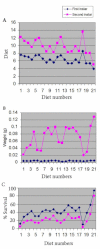Studies on the influence of host plants and effect of chemical stimulants on the feeding behavior in the muga silkworm, Antheraea assamensis
- PMID: 22243364
- PMCID: PMC3391915
- DOI: 10.1673/031.011.13301
Studies on the influence of host plants and effect of chemical stimulants on the feeding behavior in the muga silkworm, Antheraea assamensis
Abstract
The feeding habits of Antheraea assamensis, Helfer (Lepidoptera: Saturniidae) larvae towards the leaves of its four different host plants, Persea bombycina King ex. Hook (Laurales: Lauraceae), Litsea polhantha Jussieu, L. salicifolia Roxburgh ex. Nees and L. citrata Blume, and the chemical basis of feeding preference were investigated. Nutritional superiority of young and medium leaves with respect to soluble protein, total phenol and phenylalanine ammonia lyase activity was observed in the leaves of P. bombycina compared to other host plants. Attraction and feeding tests with detached leaves and artificial diet with different chemical stimulants revealed that a mixture of the flavonoids, myrcetin, and 7, 2', 4' trimethoxy dihydroxy flavone with sterol compound β-sitosterol elicited the most biting behavior by A. assamensis larvae. While linalyl acetate alone attracted larvae towards the leaves of the host plants, a mixture of caryophyllene, decyl aldehyde and dodecyl aldehyde was found to both attract them to the host leaves and cause biting behavior. Azaindole was found to deter them from the host plants.
Figures



Similar articles
-
Host plant selection by larvae of the muga silk moth, Antheraea assamensis, and the role of the antenna and maxillary palp.J Insect Sci. 2013;13:52. doi: 10.1673/031.013.5201. J Insect Sci. 2013. PMID: 23909481 Free PMC article.
-
De novo transcriptome of the muga silkworm, Antheraea assamensis (Helfer).Gene. 2017 May 5;611:54-65. doi: 10.1016/j.gene.2017.02.021. Epub 2017 Feb 17. Gene. 2017. PMID: 28216038
-
Expression of diverse midgut serine proteinases in the sericigenous Lepidoptera Antheraea assamensis (Helfer) is influenced by choice of host plant species.Insect Mol Biol. 2011 Feb;20(1):1-13. doi: 10.1111/j.1365-2583.2010.01048.x. Epub 2010 Sep 21. Insect Mol Biol. 2011. PMID: 20854480
-
Biological and genomic characterization of a cypovirus isolated from golden muga silkworm, Antheraea assamensis Helfer (Lepidoptera: Saturniidae).J Invertebr Pathol. 2025 Jul;211:108343. doi: 10.1016/j.jip.2025.108343. Epub 2025 Apr 18. J Invertebr Pathol. 2025. PMID: 40254250
-
Genome sequencing and assembly of Indian golden silkmoth, Antheraea assamensis Helfer (Saturniidae, Lepidoptera).Genomics. 2024 May;116(3):110841. doi: 10.1016/j.ygeno.2024.110841. Epub 2024 Apr 9. Genomics. 2024. PMID: 38599255
Cited by
-
Host plant selection by larvae of the muga silk moth, Antheraea assamensis, and the role of the antenna and maxillary palp.J Insect Sci. 2013;13:52. doi: 10.1673/031.013.5201. J Insect Sci. 2013. PMID: 23909481 Free PMC article.
-
Novel silkworm (Bombyx mori) sulfotransferase swSULT ST3 is involved in metabolism of polyphenols from mulberry leaves.PLoS One. 2022 Aug 4;17(8):e0270804. doi: 10.1371/journal.pone.0270804. eCollection 2022. PLoS One. 2022. PMID: 35925958 Free PMC article.
-
Transcriptome Analysis of the Carmine Spider Mite, Tetranychus cinnabarinus (Boisduval, 1867) (Acari: Tetranychidae), and Its Response to β-Sitosterol.Biomed Res Int. 2015;2015:794718. doi: 10.1155/2015/794718. Epub 2015 May 11. Biomed Res Int. 2015. PMID: 26078964 Free PMC article.
-
Air pollution tolerance index of Persea bombycina: Primary food plant of endemic muga silkworm (Antheraeaassamensis).Heliyon. 2023 Oct 22;9(11):e21184. doi: 10.1016/j.heliyon.2023.e21184. eCollection 2023 Nov. Heliyon. 2023. PMID: 37964857 Free PMC article.
-
Influence of Micronutrients on the Food Consumption Rate and Silk Production of Bombyx mori (Lepidoptera: Bombycidae) Reared on Mulberry Plants Grown in a Mountainous Agro-Ecological Condition.Front Physiol. 2019 Jul 9;10:878. doi: 10.3389/fphys.2019.00878. eCollection 2019. Front Physiol. 2019. PMID: 31354523 Free PMC article.
References
-
- Ananthakrishnan TN. Dimensions of insect plant interactions. Oxford and IBH Pub. Co. Pvt. Ltd; 1991. pp. 28–29.
-
- Bernays EA, Chapman RF. Host-Plant Selection by Phytophagous Insects. Chapman and Hall; 1994. pp. 61–94.
-
- Bossart JL, Scriber JM. Preference variation in the polyphagous tiger swallowtail butterfly (Lepidoptera; Papilionidae). Environmental Entomology. 1999;28:628–637.
-
- Brown KS, Jr., Damman AJ, Feeny P. Troidine swallowtails (Lepidopteraa: Papilionidae) in southeastern Brazil: Natural history and foodplant relationships. The Journal of Research on the Lepidoptera. 1981;19:199–226.
-
- Cantelo WW, Jacobson M. Phenacetaldehyde attracts moths to bladder flower and to black light traps. Environmental Entomology. 1979;8:444–447.
Publication types
MeSH terms
Substances
LinkOut - more resources
Full Text Sources

